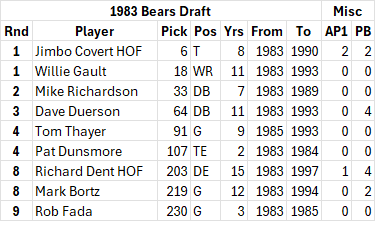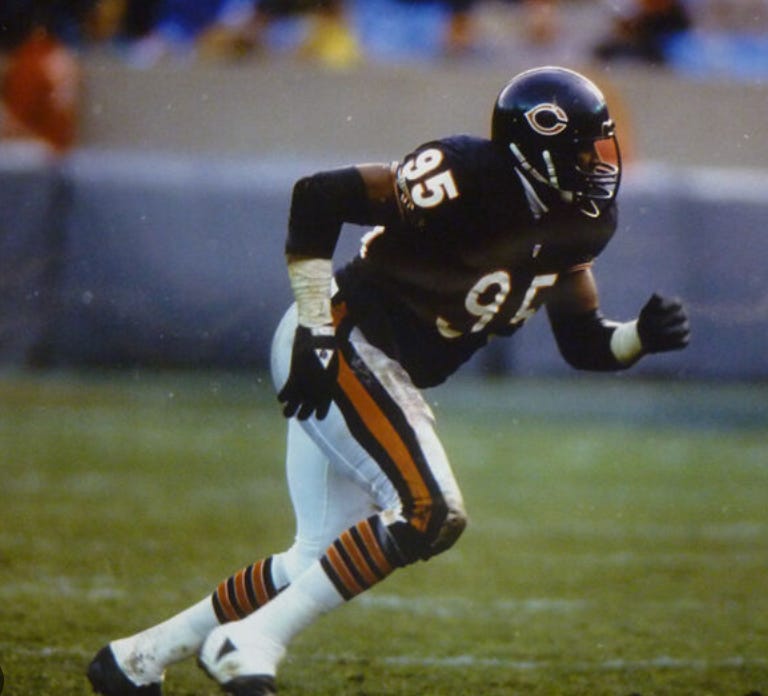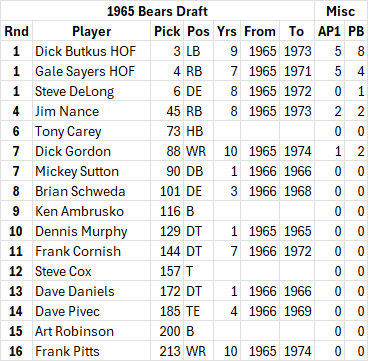
(Editor’s note: As we await the 2025 Draft that begins Thursday, April 24, here is a look at drafts from the past that were key in launching dynasties.)
Like Rome, NFL empires can’t be built in a day, but one single draft can set a foundation for a team’s eventual greatness.
Here, we present our list of the five greatest individual drafts by teams in NFL history. As becomes evident right away, the list tilts toward eras pre-dating free agency. Which makes sense. Before free agency and before the rookie contract and the salary cap compelled greater player movement, teams of yesteryear found it easier than their modern-day counterparts to develop players and keep a successful draft class intact.
We imagine that argument and this list will stir debate. What about the 1995 Tampa Bay draft that netted Hall of Famers Warren Sapp and Derrick Brooks in the first round? We hear ya. But after those two superstars, only one player from that Bucs draft played more than four years in the NFL — and that player, Jerry Wilson, spent all of his 10 seasons in uniforms other than Tampa’s.
The same reasoning could be used to keep the Ravens’ fantastic first round of the ‘96 Draft off the list. It doesn’t get much better than Ray Lewis and Jonathan Ogden, busts of whom reside in Canton. But they were the only two prospects of note from that Baltimore draft (unless you consider Jermaine Lewis and his 143 catches over nine years noteworthy).
No, we feel we got the teams on this list right. But if you wish to argue on behalf of an omitted class or want to argue the order of our selections, give us your thoughts in the Comments section.
1. 1974 Pittsburgh Steelers
By 1974, a young Steelers roster had already emerged as a playoff contender, making the AFC Championship Game in 1972 (thanks to the Immaculate Reception) and the Divisional Round the following year. But it was the ‘74 Draft that would catapult Pittsburgh to four Super Bowl titles in six years and the title as the team of the 1970s.
Four Hall of Famers came in the haul, and all contributed as rookies on the first Steelers Super Bowl championship team and all the ones that followed. Receivers Lynn Swann (USC first round) and John Stallworth (fourth round) immediately gave a defense and run-reliant team some aerial firepower. One of the league’s top front sevens became without question its best with the second-round pick of Jack Lambert. Fifth-round pick Mike Webster would alternate with veteran center Ray Mansfield before anchoring the Pittsburgh offensive line for 13 seasons.
Over their careers, the four combined for 13 first-team All-Pros and 24 Pro Bowl selections.
Pittsburgh’s front office and scouting department did their homework. The acrobatic Swann, having played at national powerhouse USC, was a high-profile choice. Lambert on the other hand was a lanky, undersized and unheralded linebacker from Kent State, where Nick Saban was a teammate. Webster played on a Wisconsin team that finished eighth in the Big Ten.
In drafting Hall of Famer Joe Greene (North Texas State, 1969), and Joe Gilliam (Tennessee State, 1972), the Steelers were well acquainted with the reservoir of talent at historically Black university football programs in the South during that era. They returned to that source in 1974, selecting Stallworth out of Alabama A&M and later signing undrafted free agent safety Donnie Shell from South Carolina State. Shell would make five straight Pro Bowls (1978–82).
2. 1986 San Francisco 49ers
Prior to the 1985 Draft, the Cowboys let slip their interest in picking Jerry Rice, the prolific receiver from Mississippi Valley State, in the first round. Then-San Francisco head coach/president Bill Walsh, enamored of Rice since watching him on TV a few months prior in a Houston hotel room, knew which team he needed to get ahead of and traded up with New England to the No. 16 spot overall, one spot ahead of Dallas. Walsh gave up multiple picks but landed the record-setting receiver he coveted.
In the 1986 draft, he took the opposite approach. Rightly believing the draft teemed with talent in the middle rounds, Walsh repeatedly traded down during the day, accumulating six picks in Rounds 3 and 4 combined, and parlaying those selections into players who would drive the team’s late ‘80s success.
Future Hall of Fame DE/LB Charles Haley, a fourth-rounder, would be DPOY in 1990 before his kinky detailing of a teammate’s car was among the several behavior-related incidents that forced a trade to Dallas. Another fourth-rounder, receiver John Taylor, became a second-team All-Pro and made the game-winning catch in Super Bowl XXIII.
The 49ers also landed starting fullback Tom Rathman (second round); Auburn tackle Steve Wallace (fourth); and defensive ends Larry Roberts, their first pick at the top of the second round, from Alabama, and Miami’s Kevin Fagan (Round 4).

As it did with Rice the year before, the San Francisco front office effectively mined smaller-school talent — Haley from James Madison, Taylor from Delaware State; starting corners Tim McKyer (third round) and sixth-round pick Don Griffin played at University of Texas Arlington and Middle Tennessee State, respectively.
(Let’s not forget how important rookie defensive backs were to an earlier seismic draft for the 49ers’ franchise. In 1981, Walsh took three DBs — Ronnie Lott, Eric Wright and Carlton Williamson — who started as rookies on San Francisco’s first title team and who all made the Pro Bowl in 1984, the team’s second Super Bowl championship.)
Walsh’s wheeling and dealing helped replenish an aging roster. From 1987–1990, the 49ers posted a regular season record of 51-12 and won two Super Bowls. He may best be known as a championship-winning coach and mastermind of the West Coast Offense, but Walsh’s command of the draft process deserves a lot of ink.
3. 1983 Chicago Bears
The 1983 draft is well-known for the volume of QBs taken in Round 1 (six in total). But the entire draft exceeded expectations, with a bumper crop of Pro Bowl and Hall of Fame-bound players scattered throughout the 12 rounds.
No team capitalized on this slew of talent better than the Chicago Bears and their legendary GM Jim Finks, who stocked the 1985 Super Bowl champions with seven starters from this class.
Chicago’s dominant “46 defense” took center stage during their Super Bowl XX-winning season, but equally important, if less discussed, was the Bears’ offensive line, largely built with prospects from the 1983 draft. Finks used the No. 6 overall pick, the first of two Round 1 selections, on Pittsburgh tackle Jimbo Covert, who became a member of the NFL’s All-Decade Team of the 1980s and a Hall of Fame inductee. Iowa guard Mark Bortz, an eighth-round pick, would be a 12-year starter and two-time Pro Bowl selection. Fourth-round selection Tom Thayer, from Notre Dame, signed with the USFL before joining the Bears as a rookie starter on the 1985 title squad.
With Chicago’s other pick in the first round, Chicago took Tennessee’s Willie Gault at No. 18 overall. A wide receiver with Olympic sprinter speed — he was a track-and-field member of the U.S. Olympic team that boycotted the 1980 Games — Gault became quarterback Jim McMahon’s favorite deep target.
The Bears’ fabled D did benefit greatly from the ‘83 talent infusion. Finks solidified the secondary in Rounds 2 and 3 with the picks of Arizona State corner Mike Richardson and Dave Duerson, a teammate of Thayer’s with the Fighting Irish.
And then there was defensive end Richard Dent. It’s hard to imagine such a pass-rushing force lasting to the eighth round, which Dent did, but an interesting backstory accompanies his rise to NFL prominence. When scouting Dent, the Bears discovered the Tennessee State end had trouble eating because of bad teeth. After drafting him, the organization spent a few grand to fix his choppers, and Dent quickly added 30 pounds to his rangy frame. He emerged as a dominant player by his second season in what would be a Hall of Fame career, punctuated by a Super Bowl MVP following the ‘85 campaign.
So, kids, if you want first-round money, remember to floss.
4. 1958 Green Bay Packers
Going back to the days before color was invented, the Packers took three players who became fixtures of the team’s tyranny over the NFL in the 1960s. Within the first four rounds of the 1958 Draft, the Packers selected LSU fullback Jim Taylor, Illinois linebacker Ray Nitschke and guard Jerry Kramer from Idaho. All three would be Hall of Famers, molded into greatness by the legendary Vince Lombardi, who took over as head coach a year later.
Kramer pulling and leading Taylor or halfback Paul Hornung were hallmarks of Lombardi’s famed Packer Sweep. The guard (along with center Ken Bowman) clearing a path for a Bart Starr sneak into the end zone to win the 1967 NFL Championship (the “Ice Bowl”) might be the most watched block in league history. Kramer’s autobiography of Green Bay’s final title season under Lombardi (1967), Instant Replay, is a must read for anyone wanting a glimpse into what made the 1960s Green Bay dynasty tick.
Nitschke was one of the best middle linebackers in an era chock full of ‘em. The Packers boasted six — six! — Hall of Famers on defense but none more revered and feared than Nitschke, who leveraged his on-field gap-tooth punisher image into a memorable prison guard role in the original The Longest Yard (though, admittedly, he gets the worst of the punishment).
5. 1965 Chicago Bears
Imagine you’re a Chicago Bears fan at the turn 1964. The Monsters of the Midway just won the 1963 NFL title game a couple of days before, and, at a New Year’s Eve party, you overhear a soothsayer soothsaying that within the calendar year your fave team will draft the most electrifying running back of the 1960s and a middle linebacker so imposing that his name will become synonymous with the position.
That Bears’ fan probably thought to themselves “we’ll win the next five Super Bowls!,” before wondering “what the hell is a Super Bowl?”
That’s right, less than 12 months after winning the NFL title over the New York Giants — the NFL actually held its draft during that era late in the season (in this case, late November) just after college football’s regular season concluded, in order to get a jump on the upstart AFL — the Bears would select the greatest duo of first-round picks made by any NFL team, ever. With the No. 3 overall selection, they took Illinois linebacker Dick Butkus. With the No. 4 overall pick, they grabbed the “Kansas Comet,” running back Gale Sayers.
As a rookie, Sayers shaked and baked the NFL to its core, scoring a then-NFL single-season record 22 touchdowns, including six against the 49ers on a muddy Wrigley Field — the Bears played there before moving to Soldier Field in 1971 — in one of pro football’s most mesmerizing individual performances.
Though Chicago had earned the aforementioned “Monsters” nickname in the early ‘40s, Butkus personified it like no Chicago player before his NFL arrival or since. Not just a fearsome tackler and terrifically agile athlete for his size, the former Illini standout brought to the field an almost overpowering mystique — an “odor,” former Baltimore Colts center Bill Curry called Butkus’s jarring presence.
Despite the impact and aura of these two players, the Bears fell from the ranks of the league’s elite, eventually bottoming out with a 1-13 record in 1969. The descent came in part because of a devastating knee injury suffered by Sayers in 1968. He would return the following season but was a shell of his former slithering, darting glory.
Remarkably, though the Bears won just one game in 1969 and he himself played on an injured knee in 1970, Butkus earned league Defensive Player of the Year honors in both seasons. He retired in 1973 with an NFL record 27 fumble recoveries.
So, yes, the sheer weight of Sayers and Butkus’ greatness puts the Bears’ 65 draft on a list that is otherwise exclusive to championship teams. But let’s not forget that Chicago had 18 other picks that draft, which included halfback Jim Nance and receiver Dick Gordon. Nance rebuffed the Bears and signed with the then-Boston Patriots, for whom he led the AFL in rushing during the 1966 and 1967 seasons. Gordon made the Pro Bowl with Chicago in 1970 — significant since no Bears receiver would make that claim for another 32 years.













The #NFL draft Shedeur Sanders saga is Keeping Up with the Kardasians for men. Convince me otherwise.
Or the dirty dozen for the Cowboys in 1975.